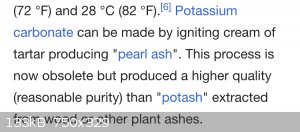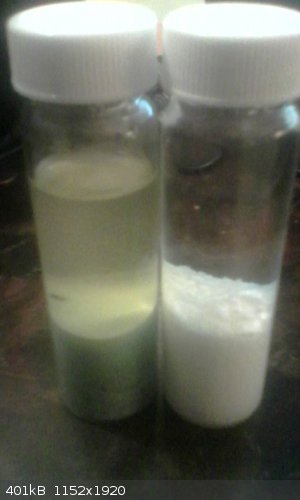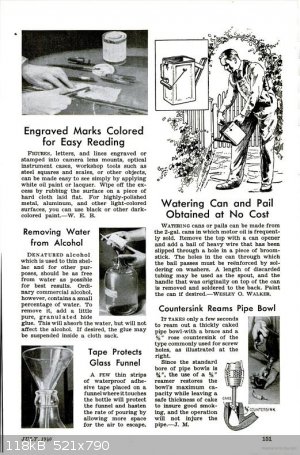| Pages:
1
2 |
PrussianBlue
Harmless

Posts: 38
Registered: 20-1-2018
Member Is Offline
Mood: No Mood
|
|
Aga, what are the easiest sources of KOH and Phosphoric acid? KOH doesn't seem terribly expensive on ebay and I found a 35-45% phosphoric acid source
(https://www.homedepot.com/catalog/pdfImages/ac/ac25e93c-5593...), but I'm wondering if there's an easier way. My reasoning behind the previously
discussed options is that I already have them or can very easily obtain them locally.
|
|
|
aga
Forum Drunkard
    
Posts: 7030
Registered: 25-3-2014
Member Is Offline
|
|
I got my KOH online.
The H3PO4 is/was green agricultural grade stuff.
|
|
|
XeonTheMGPony
International Hazard
    
Posts: 1636
Registered: 5-1-2016
Member Is Offline
Mood: No Mood
|
|
Go to any local spa place and ask for a spa flush, usualy it is near pure phosphoric acid with perhaps a bit of dye in it, but every where is
different so read the bottle
|
|
|
PrussianBlue
Harmless

Posts: 38
Registered: 20-1-2018
Member Is Offline
Mood: No Mood
|
|
Has anyone ever tried and/or heard of this? Probably isn’t very cost-effective, but interesting nonetheless.

|
|
|
JJay
International Hazard
    
Posts: 3440
Registered: 15-10-2015
Member Is Offline
|
|
Ok, I am finally getting started on this....
|
|
|
JJay
International Hazard
    
Posts: 3440
Registered: 15-10-2015
Member Is Offline
|
|
Oven drying my potassium carbonate resulted in little change in texture aside from some clumping at the bottom of the mixture (so it was not
anhydrous).
Adding oven-drived potassium carbonate to a vial of quintuple distilled 191 proof rum resulted in some minimal clumping and a small but perceptible
temperature increase. I'm drying out some copper sulfate....
|
|
|
JJay
International Hazard
    
Posts: 3440
Registered: 15-10-2015
Member Is Offline
|
|
My copper sulfate is discoloring the ethanol. I think it contains an impurity... ferrous sulfate, perhaps. Ugh...

|
|
|
RogueRose
International Hazard
    
Posts: 1585
Registered: 16-6-2014
Member Is Offline
|
|
Quote: Originally posted by JJay  | My copper sulfate is discoloring the ethanol. I think it contains an impurity... ferrous sulfate, perhaps. Ugh...
|
Mine was like this as well when I dried with CuSO4, maybe not quite as bad but it was cloudy and a brownish color. Even if there is some FeSO4, very
little would dissove in the ethanol unless there is a lot of water in the ethanol you are trying to dry.
You need to filter the ethanol through the CuSO4 and it will probably be cloudy. Then run it through the CuSO4 again and it should remove the
cloudyness, that is what I did and mine is extremely clear.
How fine was the CuSO4 you used? Was it powdered or just small crystals. The filtration should work if it was powdered.
Another option would be passing it through a little bit of activated carbon powder if the CuSO4 doesn't filter it out.
What temp did you dry the sulfate to and what color was it?
Is the alcohol the rum you started with, the 191 proof? Was it clear or did it retain some color if it was amber to start with?
[Edited on 4-3-2018 by RogueRose]
|
|
|
JJay
International Hazard
    
Posts: 3440
Registered: 15-10-2015
Member Is Offline
|
|
Quote: Originally posted by RogueRose  |
Mine was like this as well when I dried with CuSO4, maybe not quite as bad but it was cloudy and a brownish color. Even if there is some FeSO4, very
little would dissove in the ethanol unless there is a lot of water in the ethanol you are trying to dry.
|
Hmm... you raise a good point... ferrous sulfate probably wouldn't turn green under those conditions either....
I am pretty sure my CuSO4 was not quite pure because I could see some grey/brown discoloration in it after I dehydrated it before I powdered it.
I always wondered why recrystallizing CuSO4 was such a popular experiment  I
checked the ethanol with a hydrometer right before the experiment. It came in at 191 proof. The ethanol is clear and has low odor. I haven't treated
it to remove ketones, esters, aldehydes, acids, etc., but I expect that they are present in very low amounts. I
checked the ethanol with a hydrometer right before the experiment. It came in at 191 proof. The ethanol is clear and has low odor. I haven't treated
it to remove ketones, esters, aldehydes, acids, etc., but I expect that they are present in very low amounts.
[Edited on 4-4-2018 by JJay]
|
|
|
RogueRose
International Hazard
    
Posts: 1585
Registered: 16-6-2014
Member Is Offline
|
|
Quote: Originally posted by JJay  | Quote: Originally posted by RogueRose  |
Mine was like this as well when I dried with CuSO4, maybe not quite as bad but it was cloudy and a brownish color. Even if there is some FeSO4, very
little would dissove in the ethanol unless there is a lot of water in the ethanol you are trying to dry.
|
Hmm... you raise a good point... ferrous sulfate probably wouldn't turn green under those conditions either....
I am pretty sure my CuSO4 was not quite pure because I could see some grey/brown discoloration in it after I dehydrated it before I powdered it.
I always wondered why recrystallizing CuSO4 was such a popular experiment  I
checked the ethanol with a hydrometer right before the experiment. It came in at 191 proof. The ethanol is clear and has low odor. I haven't treated
it to remove ketones, esters, aldehydes, acids, etc., but I expect that they are present in very low amounts. I
checked the ethanol with a hydrometer right before the experiment. It came in at 191 proof. The ethanol is clear and has low odor. I haven't treated
it to remove ketones, esters, aldehydes, acids, etc., but I expect that they are present in very low amounts.
[Edited on 4-4-2018 by JJay] |
The discoloration is totally normal for CuSO4. Did you dry it in an oven? I've done it under a broiler and by just baking it at 500 - 550F.. The
decomp point of CuSO4 is about 1040F so I doubt I've ever gotten it that hot. I thought I was getting some CuO on the top where it was exposed to the
broiler, but the same happened when I baked it, the top got brown.
The odd thing is mine turns pinkish-grey when it is dehydrated, then when exposed to air for a few hours, it turns white (which is supposed to be the
anhydrous color), then I get a very light blue, then the normal blue of the pentrhydrate. I believe there is a monohydrate as well which may be the
white/light blue.
Like I said, filter the ethanol through the sulfate, twice, and I think you will have good results. When I used vacuum I pulled about 20% more
ethanol out of the sulfate as it adheres to the salt and when under vacuum it becomes a texture somewhat like mildy damp sand - it is a strange
texture, feels damp, but is totally dry (no water, just EtOH that evaporates quickly).
Reusing the sulfate is really easy after you have powdered it and used it to dry. Just heat and then it crushes to powder again very easily.
|
|
|
MrDoctor
Harmless

Posts: 7
Registered: 5-7-2022
Member Is Offline
|
|
is it totally neccesary to dry it ALL the way though? i recently had a conversation with someone that told me, above 95% only the 95% azeotrope boils
out, meaning that you can seperate something like 98% into an almost equal volume of anhydrous and 95%, and just repeat the process using easily
regenerated simple desiccants. i cant find any literature that confirms this, but i also cant find any explicit information to the contrary either,
and they swear to the success in a few applications that do demand >99% ethanol.
I realize it might not be a substitute but it does appear to eliminate the need for an unreasonable degree of thoroughness, for quickly deriving
absolute EtOH from 95% hardware store spirits. I was only entertaining this line of thought at all because my 3A sieves are a VERY long way away and i
just ran out of absolute EtOH
|
|
|
pneumatician
Hazard to Others
  
Posts: 409
Registered: 27-5-2013
Location: Magonia
Member Is Offline
Mood: ■■■■■■■■■■ INRI ■■■■■■■■■■ ** Igne Natura Renovatur Integra **
|
|
Pop-Sci

[Edited on 18-9-2022 by pneumatician]
|
|
|
PirateDocBrown
National Hazard
   
Posts: 570
Registered: 27-11-2016
Location: Minnesota
Member Is Offline
Mood: No Mood
|
|
For methanol or ethanol, powdered magnesium, let the hydrogen evolve, then distill off the alcohol from the MgO residue in the pot.
Store on sieves.
[Edited on 9/19/22 by PirateDocBrown]
Phlogiston manufacturer/supplier.
For all your phlogiston needs.
|
|
|
Dr.Bob
International Hazard
    
Posts: 2658
Registered: 26-1-2011
Location: USA - NC
Member Is Offline
Mood: No Mood
|
|
I know that mole sieves and alumnia are used commercially for drying ethanol now, few places use benzene azeotrope, due to hazards.
|
|
|
Mateo_swe
National Hazard
   
Posts: 505
Registered: 24-8-2019
Location: Within EU
Member Is Offline
|
|
The K3PO4 method sounds very nice but how hard is the salt to make from KOH and Phosphoric acid?
From the thread:
"K3PO4 was prepared by reacting 3 mol equivalents of KOH with phosphoric acid.
This is a bitch to get to crystallise and dry, however determined boiling and a couple of hours in an oven @ 130 C worked to yield dry white powder
(the hydrated crystal lumps are rock hard, a bit like Al Sulph)."
Do one need to pulverize the rock hard K3PO4 before the ethanol dehydration?
Maybe its easier to use the CuSO4 method, it seems very straightforward and i have read many successful attempts using this method.
And it doesnt need to be distilled afterwards, just filter and its ready for use or storage over some dried 3A mol sieves.
|
|
|
Dr.Bob
International Hazard
    
Posts: 2658
Registered: 26-1-2011
Location: USA - NC
Member Is Offline
Mood: No Mood
|
|
You can still buy Trisodium phosphate at many hardware stores as TSp, but some have been swapped with other compounds. I think in Cal, they sell
something useless as "TSP" like sodium bicarb.
|
|
|
Bedlasky
International Hazard
    
Posts: 1219
Registered: 15-4-2019
Location: Period 5, group 6
Member Is Offline
Mood: Volatile
|
|
But don't forget that Na3PO4 is usually sell as dodecahydrate.
|
|
|
Texium
|
Thread Moved
14-9-2023 at 12:01 |
| Pages:
1
2 |